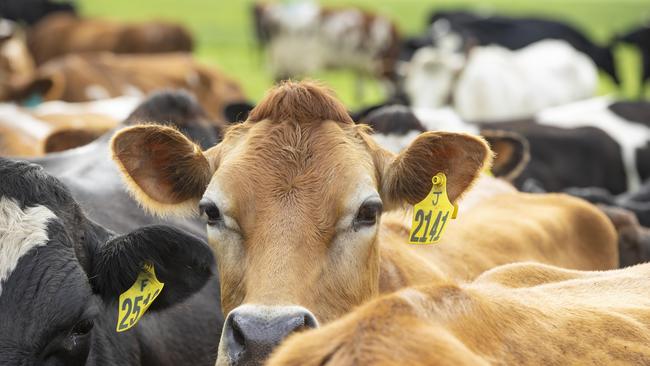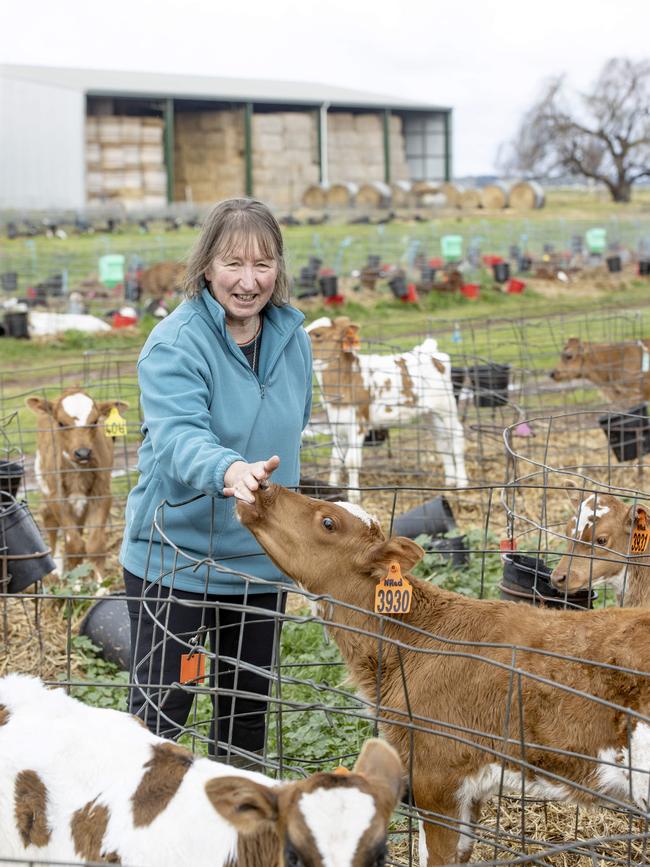Finley dairy farmers not shy to expand
Teamwork and attention to detail have allowed a Riverina dairy business to grow exponentially from milking 167 cows to 1860.
Teamwork and attention to detail have allowed a Riverina dairy business to grow exponentially from milking 167 cows to 1860 cows.
Ruth and Neville Kydd and their two sons Daniel and Steven from Finley, in southern NSW, will start using their third rotary dairy in the next couple of weeks.
Their philosophy of working hard to make dreams come true is paying dividends as they drive profits in their year-round milking venture.
The new 80-cow dairy has been installed to help manage the logistics of a round trip of the 2023ha property involving cows walking up to 10km. However, the daily average is closer to 2.5km.
It’s not just an upgrade in terms of infrastructure. The other two 50-head rotary dairies will stay operational, and the new one will add to overall economies of scale. The twice-daily milking will now involve running three dairies in succession.
“It’s a huge workload, but you can get huge results too, and it needs to be a team effort because you can’t do it on your own,” Ruth said.
What started out as a share-farming operation in the 1980s has now evolved into a large-scale milking business that invests in labour, expertise, and technology.
And Ruth and Neville are happy to share their successes and setbacks with others in the industry.
They have successfully navigated the path from sharefarmers in the early 1980s and were able to purchase their first property in 1985 using 40 per cent equity.
MILK AND WINTER CROPS
The pasture-based dairy farm incorporates about 45 per cent of the hectares in a winter cropping program with scope to feed the grain back to the dairy cattle.
Although if the market is better to sell directly to the silo, that’s the route they take. It all comes down to business philosophies and adaptability to the best path.
While the emphasis is on a pasture-based feeding system the cows are individually fed 1.3 tonnes of grain annually.
A 400mm average annual rainfall supplements irrigation from the Murray system, and the focus is on using pasture rather than feed pads. The price of water for delivery is around $50 a megalitre on the current market, and the actual cost to buy varies depending on the scheme’s going price.
The levels of water used also fluctuates depending on the season and the current cost per megalitre.
“Without irrigation, it’s not worth a cracker,” Neville said.
Ruth said they don’t limit growth and will continue to expand the herd and improve profit drivers.
“In the 1980s, we thought our cap was 200 cows,” she said.
And back then they were striving to milk 250 cows.
“Now we don’t put a cap on it; we go with the flow, see what works, and go from there.”

ATTRACTING EMPLOYEES AND EXPERTISE
Calving is in June and July, and currently, 600 calves are being fed. The Kydds are milking twice daily, and the operation employs nine people.
“The busiest time of the year is calving now,” Ruth said.
Ruth said they employed many qualified people, invested in their employees, and trained them. She said the dairy industry was hard work but rewarding.
The Kydd’s two sons, Daniel and Steven, work in the business.
“We will see what works and go from there; we have been growing in numbers and with the new dairy, we will be able to increase a little bit further yet,” Ruth said.
The cows produce an average of 18 to 20 litres of milk per head each day, with more than 500kg of milk solids per cow per year.
Production figures can vary depending on seasonal conditions.
“Some years we are happy with it, and other years we know we could have done better if we tried to balance inputs and outputs with milk price,” Ruth said.
The Kydds say there is movement in production, and a Holstein Friesian base may arguably provide higher figures in terms of litres.
However, they have adopted a three-way cross to provide critical attributes such as longevity, frame and walking ability. The three-way cross has also helped with boosting fertility.
Utilising the merits of hybrid vigour and drawing on attributes from various dairy breeds has allowed for a robust and productive herd.
In 1990, the Kydds began crossing Holstein Friesians with Jerseys and then adding another “red” breed, such as Ayrshires, Norwegian Red, or Aussie Reds, to create a three-way cross.
“We are looking for ease of calving and easy management of cows; they are tough, and they get on with it,” Ruth said.
The Kydds first learned about the three-way cross options after attending a dairy conference in the 1990s and listening to a speaker from the United States.
Ruth said the three-way cross helped to provide the attributes of various breeds and also prevent inbreeding.
“We try not to make things any more complicated than necessary,” she said.
The Kydds are not frightened to trial new breeds, and they concede overall production may not be as high as using straight Holstein Friesians. Still, the overall balance in fertility, structure and longevity was beneficial.
BALANCING PRODUCTION AND THE SEASON
Ruth and Neville said the overall production is directly correlated with the seasonal outlook.
They milk twice a day or three times every two days if the weather conditions are incredibly wet, and they supply Saputo Dairy Australia.
Milking twice every three days reduces walking in wet or muddy conditions if needed.
Despite the fact that much of Victoria had experienced a dry season, the Kydds said their place is wet at the moment.
The aim is for each cow to have longevity. Some of the females are doing nine or 10 lactations.
Management changes, such as a short artificial insemination window for joining and the use of the three-way cross, have helped to boost overall herd fertility.
The females are inseminated over 14 days. During that time frame, the aim is to get 68 to 70 per cent of the cows into calf.
Cows that are not in calf are then joined to a mop-up bull. The mop-up bull is mostly based on Jersey genetics for ease of calving, and the Kydds breed up to 15 of these bulls themselves annually.
“When we talk about our conception figures, it really is a measurement over a short period,” Ruth said.

The dairy relies heavily on irrigated ryegrass and clover. Many of the pasture paddocks are re-sown annually, and the perennial paddocks are sown again as needed.
“We usually sow more perennial pasture than what is needed,” Neville said.
Some supplementary feed is bought in, but the aim is to grow as much on-farm as possible.
The Kydds also like to plan ahead and have enough feed stored on farm as possible. It is not unusual for them to carry up to two years of silage supplies.




